New wetland national park ‘wonderful addition’ to conservation reserves
The new national park declared by the NSW government is still in excellent condition because its water supply remains largely intact, a top ecologist says.
The new national park declared by the NSW government is still in excellent condition because its water supply remains largely intact, a top ecologist says.
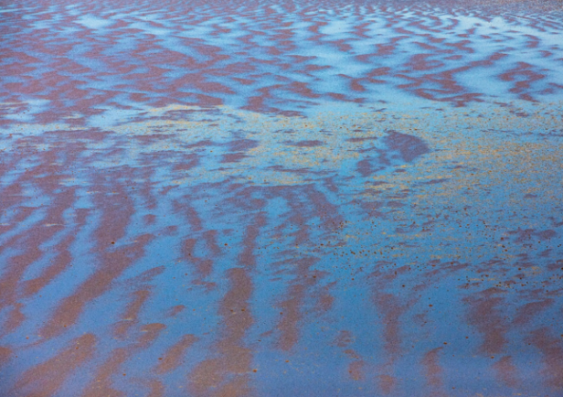
Isabelle Dubach
Media and Content Manager
+61 432 307 244
i.dubach@unsw.edu.au
The NSW government's declaration of a massive new national park in north-western NSW is a welcome and timely development, says UNSW ecologist Professor Richard Kingsford, who did the first comprehensive aerial surveys of the area’s waterbirds in the 1990s.
The purchase of the 153,415-hectare Narriearra Station is the largest acquisition of private land for national parks in the state’s history.
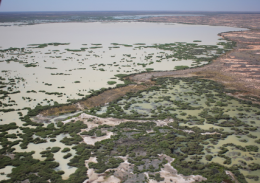
Upstream of the Bulloo Overflow, the Bulloo River reaches the Bulloo Lakes in Queensland before flooding into New South Wales. Photo: Richard Kingsford
“The park is an extensive inland wetland east of Tibooburra that includes Caryapundy Swamp and the Bullo Overflow,” says Prof Kingsford, Director of UNSW’s Centre for Ecosystem Science.
“It’s a magnificent delta system of the Bulloo River – one of Australia's magnificent free flowing rivers, supplying some fabulous wetlands. The river starts in southwestern Queensland and fills two major lake systems, the Bulloo Lakes in Queensland, before flowing over the border into the massive Bulloo Overflow in NSW. In floods, it can inundate nearly 180,000 ha, providing habitat for fish, waterbirds and other animals and plants.”
Prof Kingsford says the park is a wonderful addition to the state’s conservation reserves.
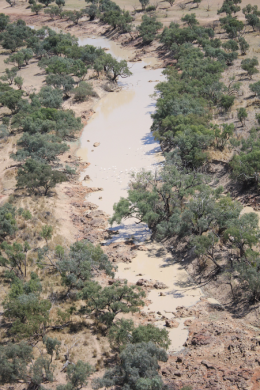
The Bulloo River in a dry time, supplying water to the Bulloo Overflow. Photo: Richard Kingsford
“The declaration of this national park is a very welcome initiative in NSW, as it will protect one of our more important wetlands areas. It is an extensive area that will also be close to the Sturt National Park.
“Generally, wetland systems have been underrepresented in our national parks – so this new national park gives this a tremendous boost and provides an area which is still in excellent condition because its water supply remains largely intact.”
Professor Kingsford did the first comprehensive aerial surveys of the area’s waterbirds in the 1990s.
“It is an amazing area of water when the Bulloo River comes down. In fact, it was so big that we had to fly transects across it in the plane when we were doing our aerial surveys.”
In June 1990, one of the only extensive surveys done, the researchers estimated that there were more than 100,000 water birds there: red-necked avocets, freckled duck, pink-eared duck and black swans.
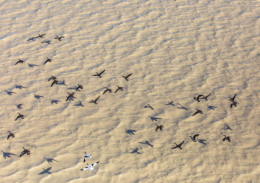
Pink-eared ducks, grey teal and red-necked avocets on the Bulloo overflow. Photo: Joshua Smith
“The wetland was so extensive and shallow and provided so much habitat for many different plants and animals – and it sustained some through a period of frenetic breeding activity,” Prof Kingsford says.
“Black swans and many other waterbirds breed in this magnificent wetland. It is also a very important area for grey grass wrens – the new area includes nearly 90 per cent of NSW’s critical habitat and breeding areas for this nationally endangered species. This very specialised bird relies on the wetland plants.”
The researchers say one of the big challenges for the future will be to protect the waters that come from Queensland to supply this extensive area.
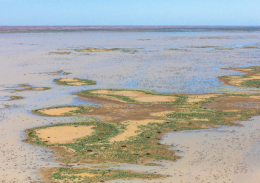
Extensive wetland areas of the Bulloo Overflow, with nests of black swans (dark clumps). Photo: Joshua Smith
“In particular, now might be a good time to consider how this particular wetland might meet criteria for Ramsar wetland designation under the Ramsar convention, as a wetland of international importance,” Prof Kingsford says.
“This would provide an opportunity for federal oversight in terms of any developments in Queensland on the Bulloo River that might restrict or reduce the flow and flooding regimes to this magnificent wetland system."